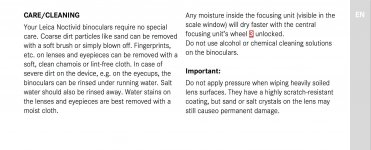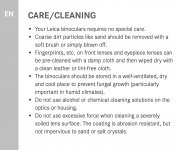PCH BIRDER
Well-known member

I received my new bins from B&H about a week ago. In a separate thread I will post my experience, but in short, I love them more every day I use them as eye placement against the upper eyelid (wearing no glasses) becomes more natural and automatic. I have noticed some very small spots on the lenses and want to be sure they clean up and are not a problem while I'm inside my 30 day return window.
I'm getting ready to order from B&H a package of the Zeiss pre-moistened wipes, along with a new air blower and a new camel hair brush. My thought was that I would blow, use the brush if needed, and then clean the lens very gently with the pre-moistened wipe, finishing with a lens cleaning cloth that has never been used (saving the one that came with the binocs in case it must be returned). I know that the general wisdom on cleaning is do as little as possible, but if I don't clean I won't know for sure that I didn't get a pair with small spots in the lens. I don't think that is the case but I want to find out while I can still return if necessary.
And having written this, it just occurred to me that perhaps I should call B&H before doing any cleaning to be sure that would not be a potential problem for a return?
Any thoughts, recommendations or cautions? Thanks very much.
I'm getting ready to order from B&H a package of the Zeiss pre-moistened wipes, along with a new air blower and a new camel hair brush. My thought was that I would blow, use the brush if needed, and then clean the lens very gently with the pre-moistened wipe, finishing with a lens cleaning cloth that has never been used (saving the one that came with the binocs in case it must be returned). I know that the general wisdom on cleaning is do as little as possible, but if I don't clean I won't know for sure that I didn't get a pair with small spots in the lens. I don't think that is the case but I want to find out while I can still return if necessary.
And having written this, it just occurred to me that perhaps I should call B&H before doing any cleaning to be sure that would not be a potential problem for a return?
Any thoughts, recommendations or cautions? Thanks very much.
Last edited:







